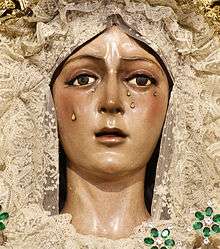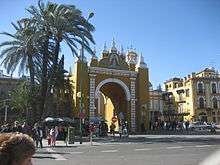Macarena, Seville
La Macarena is the traditional and historical name of the area of Seville (Spain) located north of the city center. Nowadays, La Macarena is the name of the neighborhood placed on both sides of the north city wall, but also a much bigger administrative district of Seville.


Etymology of the toponym Macarena
The origin of the toponym Macarena is disputed. Whereas some authors think that it is derived from Arabic, others maintain that it is from Latin.
Regarding Latin, Macarena would be derived from the male name Macarius. It is supposed that a patrician named Macarius would have been an important Roman landowner in this area.[1] On the other hand, it is known that during Muslim rule, the still existing city-wall gate was named Bab-al-Makrin,[2] which could be related with to the current denomination Macarena.
The neighbourhood of La Macarena lends its name to the sculpture of Virgin of Hope of Macarena, sometimes known simply as La Macarena.[3] Many Sevillian women are named after this statue. It should be noted that this is, in origin, the reason for the name of Los del Río's Spanish-language song "Macarena".
Monuments and landmarks
The neighborhood is known for housing the Basilica of Nuestra Señora de la Esperanza Macarena (Our Lady of Hope Macarena), seat of the homonymous Holy Week brotherhood. The procession in the early morning of Good Friday is one of the largest, most popular, and fervent in the whole of Spain. The wooden statue of Our Lady of Hope Macarena dates from the 17th century. The Neobaroque Basilica was built by Aurelio Gómez Millán in the 20th century.[4] Next to the church is placed the Museum and Treasure of La Macarena, where the huge artistic and sentimental patrimony of the brotherhood is exposed, working as a complete explanation about the famous Holy Week processions of Seville.
The largest remaining portion of the Almohad city walls persists in La Macarena neighbourhood. It spans between two of the old city gates, from the monumental Puerta de la Macarena (Macarena gate) at west, next to the Basilica, to the Puerta de Cordoba (Córdoba gate) at east, annex to San Hermenegildo church.

The Parliament of Andalusia is housed in the old building of the Hospital de las Cinco Llagas (literally, Hospital of the Five Holy Wounds). Dated from 16th century, it is one of the best examples of Andalusian Mannerism.
The Torre de los Perdigones (literally, Tower of the Pellets), placed in Los Perdigones gardens next to the Guadalquivir river, is the last remain of a foundry building from the late 19th century. Since 2007 it contains a panoramic room-sized camera obscura.[5]
In the nearby Feria street is located the oldest marketplace of Seville, the Mercado de la Feria. The building dates from 18th century and [6] the greengrocer's, butcher's and fishmonger's stalls constitute a traditional and picturesque scene of Seville daily life.
Transport
One can get to and from La Macarena by bus. The TUSSAM C3/C4 lines are circular, running clockwise and counter clockwise all along the periphery of the historical center, and have many stops in the neighborhood. Lines C1/C2 are also circular, and connect La Macarena with outer neighbourhoods, such as Nervión, La Cartuja and Los Remedios.
Gallery
 Hotel Macarena
Hotel Macarena Hall of the Basilica of Our Lady of Hope Macarena
Hall of the Basilica of Our Lady of Hope Macarena.jpg) Pumarejo Palace
Pumarejo Palace La Ronda
La Ronda Florencio Quintero street
Florencio Quintero street Córdoba Gate
Córdoba Gate Relator street
Relator street Hospital de Las Cinco Llagas
Hospital de Las Cinco Llagas City Wall
City Wall
References
- ↑ "Tapeo sevillano: La Macarena ruta gastronomica". Apoloybaco.com. Retrieved 2013-04-29.
- ↑ "Arco de la Macarena".
- ↑ "Conocer Sevilla... sitios con solera: el Barrio de La Macarena".
- ↑ "Brotherhood of La Macarena (Seville)". hermandaddelamacarena.es. Retrieved 28 May 2011.
- ↑ Archived 26 May 2011 at the Wayback Machine.
- ↑ "Mercado de la Calle Feria - Conocer Sevilla Informacion - Grupo Arte Sacro". Artesacro.org. Retrieved 2013-04-29.
| Wikimedia Commons has media related to Macarena. |
Coordinates: 37°24′15″N 5°59′25″W / 37.40417°N 5.99028°W